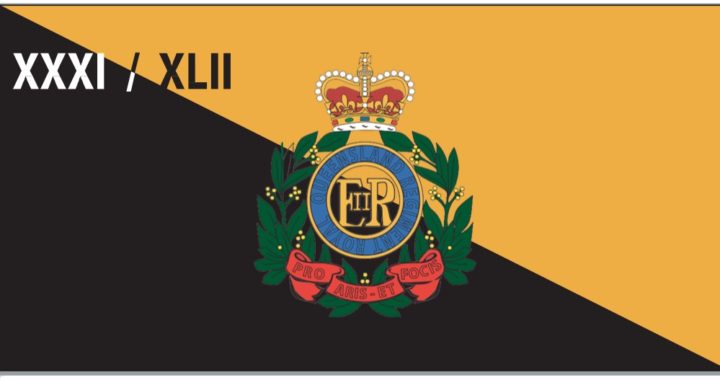ON THE WEEK-END of September 19 and 20, current and former members of the 31st and 42nd Infantry Battalions will gather in Townsville for an expanded program that will include the regular Commemorative Church Service on Sunday and an addition Stone Laying at Lavarack Barracks on Saturday.
For many years the annual Kennedy Regiment Commemorative Service was held in the Garrison Church at The Rocks in Sydney — the first Church built in the new colony for use by the military. With the passage of time and the deaths of many veterans who had been regular participants, attendance has dropped to a level where future Commemorative Services were seriously at risk.
In 2014, the first Townsville service was held in St James Cathedral.
Following the service, Association president Greg Stokie said all involved were delighted with the turn-out and the format of the Service. “It will serve as a blueprint for future years,” he added.
“The Association now has a plaque in the Cathedral in the Warrior Chapel, which was placed by Dean Rod during the Service.
“Although only a basic plaque at the moment, it is hoped that a plinth detailing the date placed and other information can be added for next year.”
This year, to mark the formation of the 31st/42nd Infantry Battalion, a Stone Memorial Dedication Service will be conducted on Saturday, August 19, 2017, in the Passchendaele Lines at Lavarack Barracks — which house the 11 Brigade headquarters.
Warrior born from the Union of a Bull and Goddess
With the assistance of the 2IC of 31/42 Battalion the Royal Queensland Regiment, MAJ Ian Reid, following is the reasoning behind the Unit Colours and Symbology.
31/42 RQR Unit Colour Patch (UCP)
When 31 RQR was linked to 42 RQR as part of the raising of 31/42 RQR, one of the two Units had to relinquish their Unit Colour Patch (UCP), as only one UCP can be worn.
The custom is that the colour patch of the more senior Unit is adopted. In this instance, the senior Unit was the 31st Battalion.
The 31/42 RQR is the only Unit in the Australian Army that now wears this UCP. The UCP was originally issued to 31st Battalion during World War 1.
It is interesting to note that the 42 RQR is the only Unit that has been continuously linked with 11 BDE since UCP were first issued.
The 31/42 RQR UCP Colours are Yellow (117C or PMS 137) and Mid Brown (411C).
31/42 RQR Lanyard
The 31/42 RQR Lanyard is Black and Gold.
These colours represent the Unit Lanyard Colours from 31 RQR (Black) and 42 RQR (Gold), and are used to give the order of seniority of a Battalion with in its Regiment. That is to say, an Infantry Unit in the Royal Australian Regiment (RAR), and a Unit in the Royal Queensland Regiment (RQR) could both have the same coloured lanyard — ie, 2RAR and 31RQR wore a Black Lanyard, with 5RAR and 42RQR wearing a Gold Lanyard. The Unit’s higher lineage is revealed by their Regimental Badge and UCP.
The 31/42 RQR Lanyard is Black and Gold.
Unit Flag colour positions are set out below, senior colour bottom left:

Flag design without Regimental crest (left) and Flag with USP overlay (right).
31st/42nd The Royal Queensland Regiment
Regimental Crest/Badge:
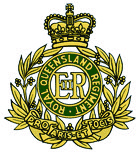
31/42 RQR Flag:
Infantry ‘Unit’ Flags reflect the Unit Lanyard Colours and have the Units Regimental Crest/Badge fitted centrally on the flag, with Roman Numerals displayed in the top Left Canton of the Flag indicating the units designation number. The use of Roman Numerals indicates a Combat Unit, while Arabic Numerals are used it indicates a non combat or supporting Unit.
Unit Shoulder Patch (USP):
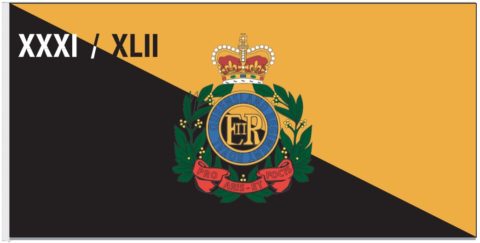
Unit shoulder patch. Unit Shoulder Patch (USP) differs from identification arm patches. Only an authorised USP may be worn. The USP is worn in barracks, with General Duty Dress (DPCU) on the velcro patch on the right sleeve of the DPCU shirt. The USP is not to be worn on operations or field exercises. Only one patch is to be worn on the right sleeve of the DPCU shirt. USP are not to be sewn onto the sleeves of DPCU shirts.
Colour Code legend
Red represents the 2nd Division.
Sky Blue with Arabic Numeral 11 – represents 11 Brigade.
Unit Colour Patch with Arabic Numerals’ and Alphabetical designator represents 31/42 RQR.
Unit Shoulder Patch (USP):
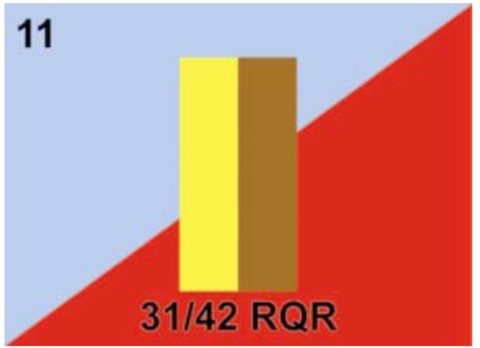
Field shoulder patch. Only an authorised Field Shoulder Patch (FSP) may be worn on the velcro patch on the right sleeve of the DPCU and AMP shirt. The FSP is worn only with Field Dress (DPCU) and AMP uniform, when participating in field related training activities or during field exercises. The FSP may be worn in the field during exercises overseas, but not on operations. The FSP may be worn in barracks, but only when Field Dress (DPCU) or AMP uniform are worn for field related training activities. The FSP is not to be worn in the barracks environment when General Duty Dress (DPCU) or AMP uniform are worn and it does not to replace the USP when this order of dress is worn. The FSP is not to be sewn onto the sleeves of the DPCU and AMP shirt.
3.149The FSP design is to be approved by the commander or unit CO and oversight for the design is to be the Bde or Formation RSM. The command oversight is to be AHQ; however, functional commands, ie HQ FORCOMD, HQ SOCOMD and HQ 1 Div are responsible to manage their respective FSP registers.
3.150The FSP design may be a subdued version of the USP or an independent low visibility design that meets the Army’s values.
3.151The design, provision and maintenance of the FSP are at the units expense, by using only non-public monies, eg Regimental Trust Funds. Commonwealth monies are not to be used in any circumstance.
3.152The wearing of the FSP is not mandatory, but units that authorise a FSP are to apply consistency within its sub-units. Sub-units FSP within a unit are not authorised to be designed or worn.
History of the 31/42 Unit ‘Field’ Patch Development
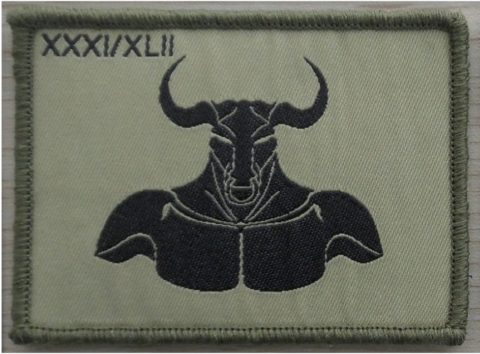
In 2016, as part of the Unit recruiting strategy, the 11 BDE PA Officer CAPT Trainer, recommended to CO 31-42 RQR, LTCOL Keith Potter, that 31/42 RQR needed to develop a ‘brand image’ to use as a tool to help market the Unit to the Army and to the general public (recruiting).
LTCOL Potter subsequently tasked Battalion Unit Recruiting Liaison Officer (URLO) WO2 Matthew Connell, and the Adjutant CAPT Ryan Muller, to commence the development of a suitable ‘brand’ with the following guidance
- the Logo needed to be modern and appealing to potential recruits and
- the Logo needed to reflect a strong military ethos and warrior image
WO2 Connell and CAPT Muller raised several ‘draft designs’ for consultancy amongst the men of the Battalion. At the end of the consultancy, the men chose the ‘Minotaur Logo’ for the following reasons;
- It reflected a well known warrior image from Greek Mythology – a warrior born from the Union of a Bull and Goddess – representing a Union of the 31st and 42nd infantry Battalions
- The bull reflected the current Unit Mascot gained from 42 RQR
- The image/brand was a simple striking image would be suitable for adoption by the Army
- The horns of the Bull also just so happen to link with the North Queensland Cowboys Rugby League Football team, which supports and represents a large proportion of the current Battalion AO.
LTCOL Potter subsequently approved the Minotaur brand logo and tasked the RSM, WO1 Maitland to confirm that the design met with Army standards, including the material colours.
When the design and colours were confirmed, the Battalion Executive Officer, MAJ Ian Reid, was tasked to commission 300 field patches.
MAJ Reid engaged the services of A1 Embroidery Services, an Army approved Unit Shoulder Patch provider to commission the Field Patch.
In September 2016, 300 patches were received by the XO for use by the Battalions Soldiers..
